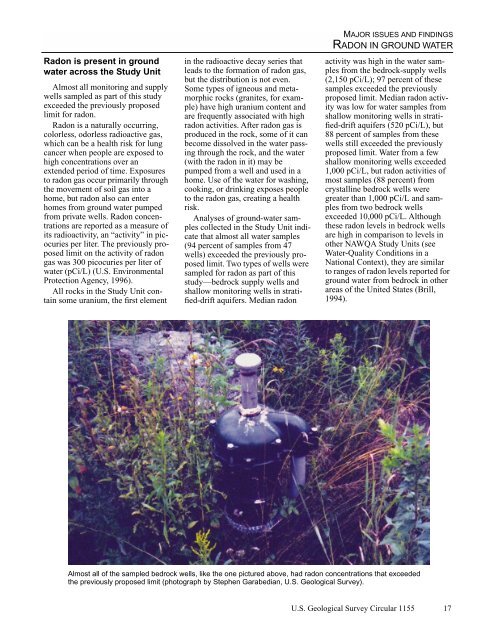Water Quality in the Connecticut, Housatonic, and Thames ... - USGS
Water Quality in the Connecticut, Housatonic, and Thames ... - USGS
Water Quality in the Connecticut, Housatonic, and Thames ... - USGS
Create successful ePaper yourself
Turn your PDF publications into a flip-book with our unique Google optimized e-Paper software.
Radon is present <strong>in</strong> ground<br />
water across <strong>the</strong> Study Unit<br />
Almost all monitor<strong>in</strong>g <strong>and</strong> supply<br />
wells sampled as part of this study<br />
exceeded <strong>the</strong> previously proposed<br />
limit for radon.<br />
Radon is a naturally occurr<strong>in</strong>g,<br />
colorless, odorless radioactive gas,<br />
which can be a health risk for lung<br />
cancer when people are exposed to<br />
high concentrations over an<br />
extended period of time. Exposures<br />
to radon gas occur primarily through<br />
<strong>the</strong> movement of soil gas <strong>in</strong>to a<br />
home, but radon also can enter<br />
homes from ground water pumped<br />
from private wells. Radon concentrations<br />
are reported as a measure of<br />
its radioactivity, an “activity” <strong>in</strong> picocuries<br />
per liter. The previously proposed<br />
limit on <strong>the</strong> activity of radon<br />
gas was 300 picocuries per liter of<br />
water (pCi/L) (U.S. Environmental<br />
Protection Agency, 1996).<br />
All rocks <strong>in</strong> <strong>the</strong> Study Unit conta<strong>in</strong><br />
some uranium, <strong>the</strong> first element<br />
<strong>in</strong> <strong>the</strong> radioactive decay series that<br />
leads to <strong>the</strong> formation of radon gas,<br />
but <strong>the</strong> distribution is not even.<br />
Some types of igneous <strong>and</strong> metamorphic<br />
rocks (granites, for example)<br />
have high uranium content <strong>and</strong><br />
are frequently associated with high<br />
radon activities. After radon gas is<br />
produced <strong>in</strong> <strong>the</strong> rock, some of it can<br />
become dissolved <strong>in</strong> <strong>the</strong> water pass<strong>in</strong>g<br />
through <strong>the</strong> rock, <strong>and</strong> <strong>the</strong> water<br />
(with <strong>the</strong> radon <strong>in</strong> it) may be<br />
pumped from a well <strong>and</strong> used <strong>in</strong> a<br />
home. Use of <strong>the</strong> water for wash<strong>in</strong>g,<br />
cook<strong>in</strong>g, or dr<strong>in</strong>k<strong>in</strong>g exposes people<br />
to <strong>the</strong> radon gas, creat<strong>in</strong>g a health<br />
risk.<br />
Analyses of ground-water samples<br />
collected <strong>in</strong> <strong>the</strong> Study Unit <strong>in</strong>dicate<br />
that almost all water samples<br />
(94 percent of samples from 47<br />
wells) exceeded <strong>the</strong> previously proposed<br />
limit. Two types of wells were<br />
sampled for radon as part of this<br />
study—bedrock supply wells <strong>and</strong><br />
shallow monitor<strong>in</strong>g wells <strong>in</strong> stratified-drift<br />
aquifers. Median radon<br />
MAJOR ISSUES AND FINDINGS<br />
RADON IN GROUND WATER<br />
activity was high <strong>in</strong> <strong>the</strong> water samples<br />
from <strong>the</strong> bedrock-supply wells<br />
(2,150 pCi/L); 97 percent of <strong>the</strong>se<br />
samples exceeded <strong>the</strong> previously<br />
proposed limit. Median radon activity<br />
was low for water samples from<br />
shallow monitor<strong>in</strong>g wells <strong>in</strong> stratified-drift<br />
aquifers (520 pCi/L), but<br />
88 percent of samples from <strong>the</strong>se<br />
wells still exceeded <strong>the</strong> previously<br />
proposed limit. <strong>Water</strong> from a few<br />
shallow monitor<strong>in</strong>g wells exceeded<br />
1,000 pCi/L, but radon activities of<br />
most samples (88 percent) from<br />
crystall<strong>in</strong>e bedrock wells were<br />
greater than 1,000 pCi/L <strong>and</strong> samples<br />
from two bedrock wells<br />
exceeded 10,000 pCi/L. Although<br />
<strong>the</strong>se radon levels <strong>in</strong> bedrock wells<br />
are high <strong>in</strong> comparison to levels <strong>in</strong><br />
o<strong>the</strong>r NAWQA Study Units (see<br />
<strong>Water</strong>-<strong>Quality</strong> Conditions <strong>in</strong> a<br />
National Context), <strong>the</strong>y are similar<br />
to ranges of radon levels reported for<br />
ground water from bedrock <strong>in</strong> o<strong>the</strong>r<br />
areas of <strong>the</strong> United States (Brill,<br />
1994).<br />
Almost all of <strong>the</strong> sampled bedrock wells, like <strong>the</strong> one pictured above, had radon concentrations that exceeded<br />
<strong>the</strong> previously proposed limit (photograph by Stephen Garabedian, U.S. Geological Survey).<br />
U.S. Geological Survey Circular 1155 17

















